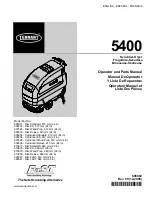
10
KX-TG9471B/KX-TG9472B/KX-TGA939T
4.2.3.
Telephone Line Interface
Note:
[ ]: Line 2
<Function>
• Bell signal detection
• Clip signal detection
• ON/OFF hook circuit
Bell & Clip (: Calling Line Identification Presentation: Caller ID) signal detection:
In the standby mode, Q101 [Q201] is open to cut the DC loop current and decrease the ring load.
When ring voltage appears at the L1T (A) [L2T (C)] and L1R (B) [L2R (D)] leads (when the telephone rings), the AC ring voltage
is transferred as follows;
ON/OFF hook circuit:
In the standby mode, Q101 [Q201] is open, and connected as to cut the DC loop current and to cut the voice signal. The unit is
consequently in an
on-hook condition
.
When IC501 detects a ring signal or press the TALK Key onto the portable, Q103 [Q203] turns on and then Q101, PC102,
[Q201, PC202] turns on, thus providing an
off-hook condition
(DC current flows through the circuit) and the following signal
flow makes the loop current.
A [C]
→
D101 [D201]
→
Q101 [Q201]
→
Q131 [Q231]
→
R124 [R224]
→
R125 [R225]
→
D101 [D201]
→
B [D]
4.2.4.
Transmitter/Receiver
• Audio Circuits and DTMF tone signal circuits.
Base unit and portable mainly consist of RF Module and DECT BBIC.
Base unit and portable transmit/receive voice signal and data signal through the antenna on carrier frequency.
Signal Path:
*Refer to
Signal Route
(P.14).
4.2.4.1.
Transmitter Block
The voice signal input from the TEL LINE interface goes to RF Module (IC801) through DECT BBIC (IC501) as shown in
Block
Diagram (Base Unit)
(P.7)
The voice signal passes through the analog part of IC501 where it is amplified and converted to a digital audio stream signal.
The burst switch controller processes this stream performing encryption and scrambling, adding the various other fields to
produce the GAP (
G
eneric
A
ccess
P
rofile) standard DECT frame, assigning to a time slot and channel etc.
In IC801, the carrier frequency is changing, and frequency modulated RF signal is generated and amplified, and radiated from
antenna. Portable detects the voice signal or data signal in the circuit same as the following explanation of Receiver Block.
4.2.4.2.
Receiver Block
The signal of 1900 MHz band (1920 MHz ~ 1930 MHz) which is input from antenna is input to IC801 as shown in
Block
Diagram (Base Unit)
(P.7).
In IC801, the signal of 1900 MHz band is downconverted to 864 kHz signal and demodulated, and goes to IC501 as GAP
(
G
eneric
A
ccess
P
rofile) standard DECT frames. It passes through the decoding section burst switch controller where it
separates out the frame information and performs de-encryption and de-scrambling as required. It then goes to the DSP section
where it is turned back into analog audio. This is amplified by the analog front end, and goes to the TEL LINE Interface.
4.2.5.
USB Interface
IC901 includes a USB2.0 full-speed function controller, USB transceiver, oscillator, one-time programmable ROM, and
asynchronousserial data bus (UART) with full modem control signals. USB and UART is bridged by IC901.
R167 [R268] - IC501 (101) [IC501 (114)]
R171 [R271] - R172 [R272] - IC171 (2) [IC171 (6)] - IC171 (1) [IC171 (7)] - IC501 (11) [IC501 (12)]
A [C] - C153 [C253] - R153 [R253] - IC161 (6) [IC261 (6)] IC161 (7) [IC261 (7)] -
B [D] - C158 [C258] - R156 [R256] - IC161 (5) [IC261 (5)]
Bell
Clip











































